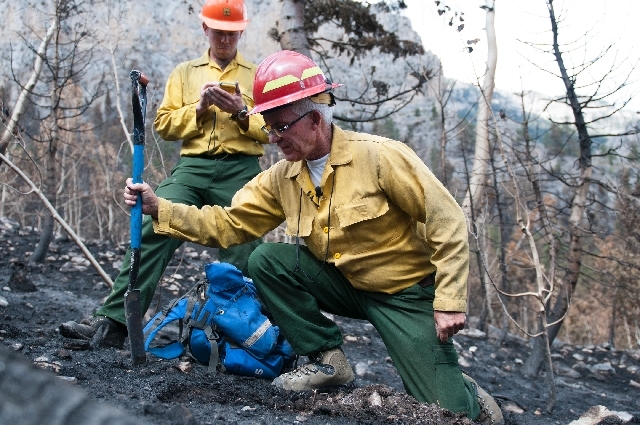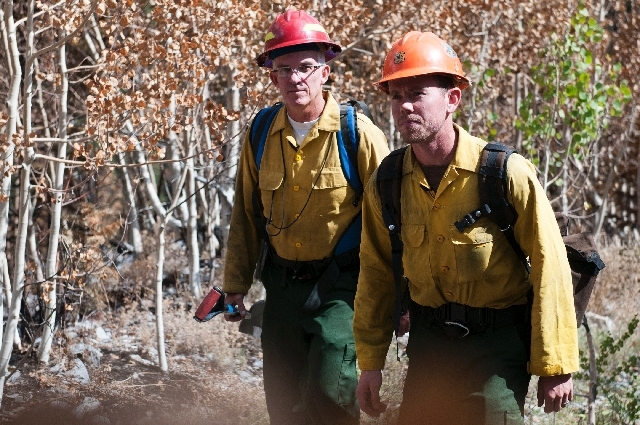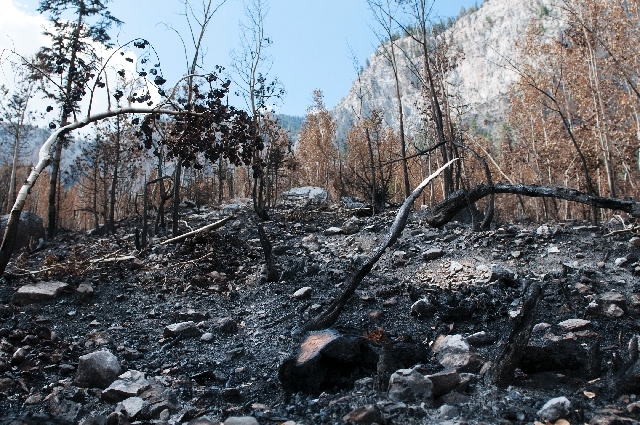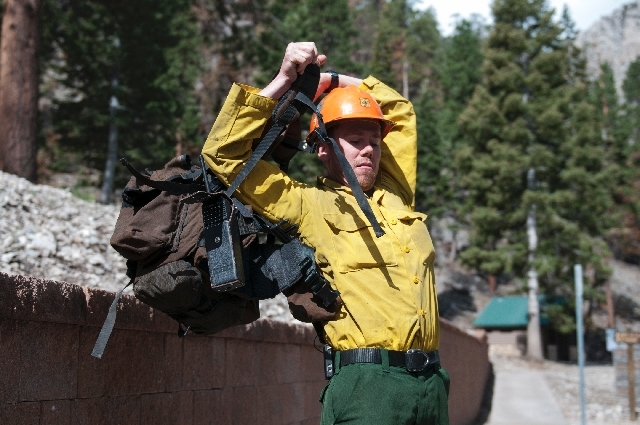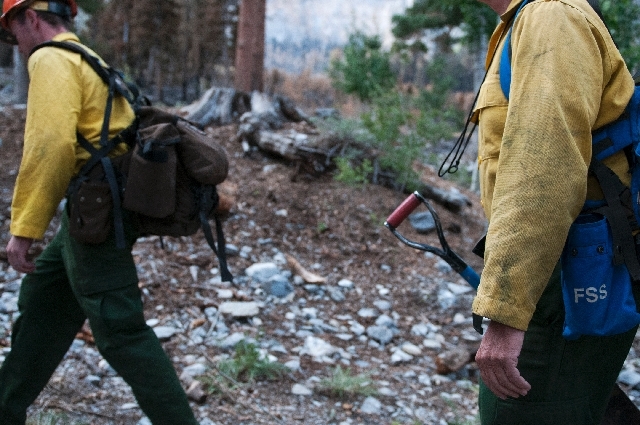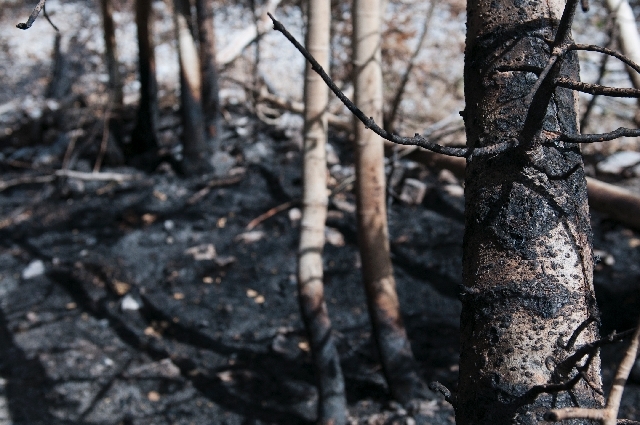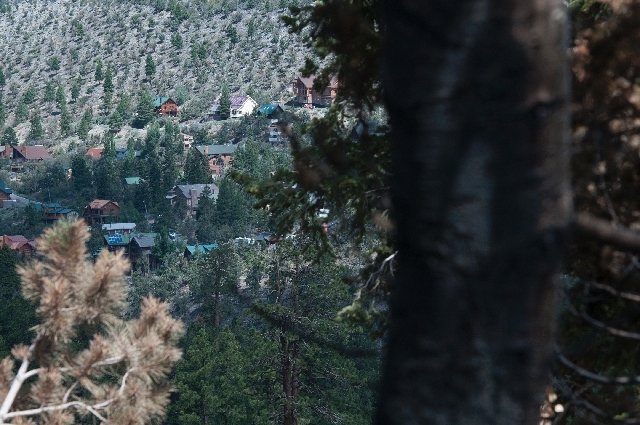Inspection shows Carpenter 1 Fire area set for eventual rebirth
Small islands of brilliant green are surrounded by mosaics of browns and blacks.
A layer of slippery, wet black ash is stark against dry white rocks and pale brown dirt.
The scent of pine is tinged by the smell of burnt wood.
Gently yellowing trees stand amid gnarled burned ones and towering fresh greenery.
This is the Mount Charleston that residents and hikers returned to after the Carpenter 1 Fire.
The fire, now at 95 percent containment, had teams of firefighters and personnel working around the clock for nearly three weeks to mitigate damage and keep it from burning homes as it scorched almost 28,000 acres of the Spring Mountains.
The fire raged, but it did not fully consume.
“This is going to be screaming with vegetation by next year,” Burned Area Emergency Response team member Brad Rust, a soil scientist with the U.S. Forest Service, said of a blackened, muddied, ash-covered area populated by aspen trees slightly above the Cathedral Rock picnic area. “By next year, this will all spring up because they grow from the roots.”
Rust, who arrived from Shasta Trinity National Forest on July 16 as part of the BAER team, took a reconnaissance flight for an aerial view of the area and studied maps and documents before he hit the ground to see how bad things were.
“It’s called ground-truthing,” he said. “It’s to confirm calls made from the air.”
Fire is a natural process that allows regrowth, Rust said. Aspens rejuvenate by thinning out the trees or by controlled burns, making them more resilient.
“It’s very, very typical,” Rust said. “There is nothing really extreme in this fire. This is the process. We’re used to this process.”
Rust conducts soil tests in the area to determine burn severity in the landscape. Cathedral Rock picnic area showed moderate soil damage under the layers of damp ash but also produced healthy roots and fungi.
Brian Anderson, a hydrologist with the BAER team and Hotshot firefighter from Boise, Idaho, looks at water flow and runoff, a concern in an area scarred by fire and prone to flash flooding.
“Often we’ll call it moonscaped if it’s really burned,” Anderson said.
To get a pre-fire and post-fire estimate of the land, Anderson and Rust work closely together, using soil samples to determine hydrology.
“We use things like digital elevation models or stream flow rainfall runoff models,” Anderson said. “We try to characterize the area as best we can as to what the initial hydrology is and then we go and take that information on the burn severity and plug that information into the model.”
Even as the fire still burns, the BAER team, including Anderson and Rust, is compiling a report with suggestions for regrowth and rebirth.
Their assessment is a rapid one as fire season slides into monsoon season.
The 15 specialists look at everything necessary to aid the rebirth of the landscape and safety issues.
In the aspen groves, Rust’s recommendation for future plans is a simple one.
“I’d let nature take it’s course.”
The team will finish their report and submit it by the end of the week or early next week, Rust said.
It will go to the forest superintendant and then the regional office for approval.
Implementation of measures will start a week to 10 days after it’s approved.
Meanwhile, the firefighting effort continues to wind down.
Brooke Nunez, who was called up from Southern California to serve as incident commander a week ago, said Wednesday that the fire might be turned over to local control by as early as next week.
BAER team members are not giving any suggestions about the charred areas yet, choosing caution over blanket statements.
Some of the assurances they did make included the short life span of the ash, which is not as harmful as people would believe.
The ash will go away pretty fast, Rust said. The plants benefit from it.
While the aspen in Kyle Canyon grow quickly and will provide a new, healthy habitat for wildlife, the pinyon juniper and the conifer trees in Trout and Lovell Canyons will take a little longer to regrow and repopulate.
Partially burned trees have a chance for survival.
If the tree is only one-third burned and the roots are intact, it generally lives on, Rust said.
Wildlife don’t seem to mind the charred areas.
Deer droppings are evident against the shiny damp ash in some of the burned areas that have thinner vegetation.
Hikers should be cautious though.
There are still dangers in the burned areas, including slippery wet ash and hot ash pits.
“When the fire’s gone, that doesn’t mean that the danger isn’t there,” U.S. Forest Service spokesman Jay Nichols said.
Reporter Henry Brean contributed to this report. Contact Rochel Leah Goldblatt at rgoldblatt@reviewjournal.com or 702-383-0381.




